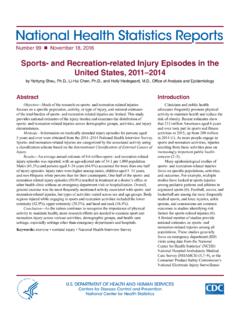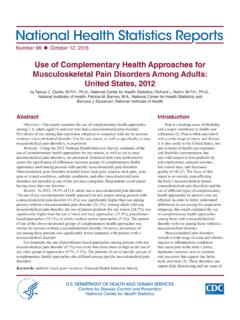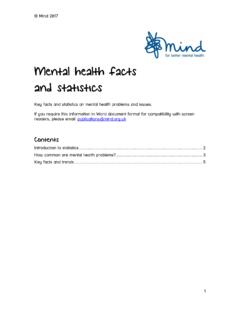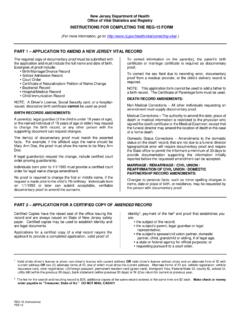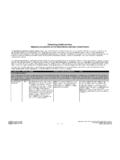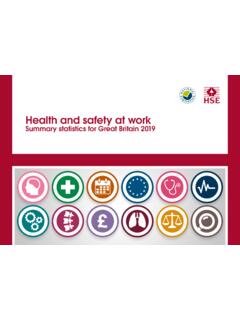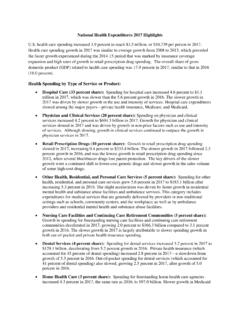Transcription of Ageing and Public Health – an overview of key statistics ...
1 Ageing and Public Health an overview of key statistics in Ireland and Northern IrelandA report prepared by the Institute of Public Health Institute of Public Health2 Ageing and Public Health an overview of key statistics in Ireland and Northern Ireland Published by The Institute of Public Health . The Institute of Public Health , 2020 Prepared by:Aideen Sheehan and Roger O SullivanTo be cited as: Sheehan, A. and O Sullivan, R., (2020) Ageing and Public Health an overview of key statistics in Ireland and Northern Ireland. Dublin: Institute of Public authors would like to thank former colleagues Conor Breen and the late Paul McGill for their work on a previous version of this report. This report is dedicated to the memory of Institute of Public Health has produced this document as a resource for Public Health on the island. It may be freely reproduced with acknowledgement but is not for resale or for use in conjunction with commercial of ContentsINTRODUCTION 41.
2 THE DEMOGRAPHICS OF Ageing ON THE ISLAND OF IRELAND 52. CHRONIC CONDITIONS AND Ageing 103. SOCIO-ECONOMIC INEQUALITIES IN Ageing AND Health IN IRELAND AND 14 NORTHERN IRELAND CONCLUSION 24 BIBLIOGRAPHY 25 Ageing and Public Health an overview of key statistics in Ireland and Northern IrelandInstitute of Public Health4 IntroductionPeople worldwide are living longer than ever before and this is also true on the island of Ireland. Over the last 100 years, average life expectancy at birth in Ireland and Northern Ireland, has risen by several decades.
3 Life expectancy at birth in ROI is years for men and for women (Eurostat, 2017a) while in Northern Ireland (NI) it is years for men and years for women (DOH NI, 2019a). Population Ageing can be seen as one of the greatest successes of Public Health . However, a key challenge is not only the extension of life expectancy but to ensure those extra years are healthy and disability-free for as long as possible. All countries face major challenges to ensure that their Health and social systems are ready to make the most of this demographic shift. Worldwide, populations are rapidly Ageing . This demographic shift presents both opportunities and of the challenges associated with population Ageing can be addressed by changes in behaviour and policy, especially those that promote good Health in older age. However, so far, the debate on how best to achieve these changes has been narrow in scope. A comprehensive Public Health approach to population Ageing that responds to the needs, capacities, and aspirations of older people and the changing contexts in which they function is needed.
4 (Beard and Bloom, 2015). Ageing is a life-long process and ensuring people can age healthily and maintain independence in old age requires a life-course approach. Public Health interventions can have a significant impact on the quality of Ageing in terms of Health outcomes, disability and quality of life. This paper highlights the areas where Public Health and Ageing intersect, particularly focusing on relevant statistics in ROI and ComparisonsIt is important to note that direct comparisons between different data sources for Northern Ireland and the Republic of Ireland must be treated with caution, due for example to the use of different survey methodologies, definitions, question wording and timeframes, or the fact some disease prevalence data is taken from official registers based on different criteria and healthcare systems. Important differences have been footnoted in the report, and more details can be found in the original sources.
5 Please note that for the reasons outlined, comparisons of trends within this paper are indicative rather than and Public Health an overview of key statistics in Ireland and Northern Ireland5In line with global trends the populations of ROI and NI are getting older and the share of older people is set to rise steeply over coming The Demographics of Ageing in Ireland and Northern IrelandFigure 1: Projected number of people aged 65+, thousands, 2019-2051 The population aged 65 or over in ROI was estimated to have reached 696,300 in 2019 and 314,700 in NI, meaning the combined total on the island has exceeded 1 million for the first time (CSO, 2019a, NISRA, 2019). Figure 1 shows the projected number of people aged 65+ doubling to almost million in ROI by 2051 and exceeding half a million in NI - bringing the total in this age group to over 2 million on the island (CSO, 2018, NISRA, 2019). The number of people aged 60 or over is estimated at 950,000 in ROI in 2019 and is projected to rise to by 2051.
6 In NI there are currently 421,000 people aged 60+ and this is projected to rise to 631,000 by 2019 one in seven people on the island of Ireland was aged 65 or over 17% of the NI population and 14% of the ROI population. It is projected that one in four people (26%) will be over the age of 65 by 2051 in both ROI and NI as shown in Figure 2. Three out of 10 people in the population of both jurisdictions will be aged 60+ by : CSO, 2018; CSO, 2019a1 ; NISRA, 20191 The 2019 figures for ROI are from the CSO s population estimates for April 2019. The CSO s M2F2 population projection based on moderate immigration and reduced fertility is used for the ROI component of the projected figures for 2021 to 2051 which are based on a 2016 starting point. All NI figures are from NISRA s 2018-based population of Public Health6 The number of people in Ireland, north and south aged 85+ is also set to accelerate over coming decades.
7 In 2019 there were 73,000 people aged 85+ in ROI and this is projected to rise to 301,000 by 2051 (CSO, 2018, CSO, 2019a). In NI there were 39,000 people aged 85+ in 2019 and this will rise to 103,000 by 2051 (NISRA 2019). One in 20 people on the island of Ireland will be aged 85+ by growth in the Ageing population has been very rapid on the island of Ireland in the last decade compared with other EU countries where this process began earlier. Growth in the older age groups far exceeds growth in other age cohorts. While ROI had one of the youngest populations in Europe for many years, by 2028 there will be more people in ROI aged 65+ than there will be children aged 0-14 (DOH, 2018a). A similar shift is projected for NI with more people aged 65+ than children aged 0-15 (NISRA, 2019).The growth of our older population since the 20th Century has been the result of many factors including: increased life expectancy due to reduced infant and maternal mortality, the elimination of many infectious diseases, improved water-quality, medical advances and healthier lifestyles.
8 This increased longevity in combination with reduced fertility led to huge increases in the share of older people in the population worldwide. Improvements in life expectancy are projected to continue over coming decades. Figure 3 overleaf shows the projected increase in life expectancy at birth in ROI from 2011 to 2051, an increase of years for women and years for men (CSO, 2018). However recent data suggest the improvements in life expectancy of recent decades have started to slow down across the island of Ireland and many high-income countries, most notably the US where life expectancy has fallen slightly since 2015 (Raleigh, 2019). In ROI the slowing of life expectancy gains has been more pronounced amongst women than men (Murphy et al, 2019), while in NI there has also been a slowdown in life expectancy gains with no significant improvement for women since 2012-14 Figure 2: People aged 65+ as a percentage of total population, 2019-2051 Source: CSO 2018; NISRA, 20197 Ageing and Public Health an overview of key statistics in Ireland and Northern Irelandand a modest increase for men (DOH NI, 2019a).
9 The stalling of life expectancy gains is not as pronounced in NI as in the UK as a whole (ONS, 2018). Reasons posited for slowing life expectancy gains in developed countries include high influenza mortality, a slowdown in cardiovascular Health improvements, and austerity, but the evidence is still unclear (Murphy et al, 2019). Increased mortality rates among the over-90s in ROI since 2011 has also been noted as a cause of concern (Naqvi and Whelan, 2019).Figure 3: Projected increase in life expectancy in ROI, 2011-2051 Source: CSO, 2018 Life expectancy at age 65 is also an important measure of an Ageing population. In ROI a woman aged 65 in 2017 had a remaining life expectancy of years while a 65-year-old man could expect to live another years (Eurostat, 2017a). In NI the corresponding figures are years for women in 2016/18 and years for men (DOH NI, 2019a).Increased longevity is not the only important measure however, as the number of those extra years spent in good Health is crucial to both quality of life and service provision.
10 Disability-free life expectancy is a measure used to assess this2. In ROI, disability-free life expectancy at age 65 has been increasing, standing at years for women and at years for men in 2017 (Eurostat, 2017a). This is higher than the European Union average of years for women and years for men, but lower than in the best-performing country Sweden where disability-free life expectancy at age 65 is years for women and years for men. In NI meanwhile the figures for disability-free life expectancy at age 65 (calculated by the Office of National statistics ) to allow for UK-wide comparisons show a woman in NI could expect to live years disability-free in 2016-18, while a 65-year-old man could expect to live more years disability-free,, several years less than their female and male counterparts in ROI as shown in Figures 4a and 4b overleaf, though differences in how this is measured must be taken into account (ONS, 2019).
